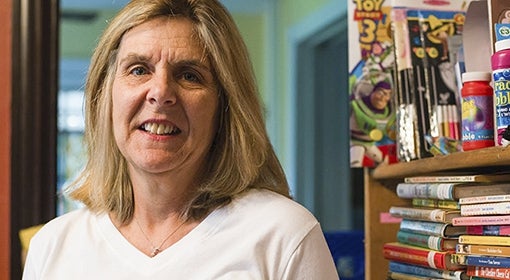Rebecca Skloot walked the red carpet, shoulder to shoulder with Oprah Winfrey, linking arms with actress Rose Byrne. She smiled radiantly in a silvery jumpsuit, easily blending into the Hollywood royalty flanking her as the cameras flashed.
“Look right!” “Look left!” shouted the photographers inside the SVA Theatre in New York City. It was a surreal celebrity moment for Skloot, who is a best-selling author, not a movie star. But the real drama would come an hour later, when the Pitt alumna settled into her seat to watch 11 years of her life condensed into a 90-minute, star-studded film.
It was another extraordinary chapter in a personal and professional journey decades in the making.
Skloot was sitting in a community college science class when she first heard the name of the woman whose story would transform her life. She was a 16-year-old fascinated by medical science and taking the course for high school credit.
The instructor chalked the name across the blackboard: Henrietta Lacks. In 1951, he explained, this woman’s cancer cells became the first immortal human cells grown in a laboratory. Long after her death, her cells—coined HeLa—lived on, replicating again and again. Most cell lines are unable to reproduce indefinitely, so the growth of HeLa cells proved uniquely valuable to medical research. They became a vital tool, playing a role in many of modern medicine’s most important feats, including the development of vaccines and medicines, gene mapping, cloning, and in vitro fertilization.
The teenager was enthralled. Who was this woman and why wasn’t her story well-known? Skloot’s teacher didn’t have answers, and neither did the textbook or her parents’ encyclopedia. Even so, the name stuck with her. She wanted to know more about the woman behind HeLa.
“I have always been a very hard-headed, determined person,” Skloot says.
It took time to hone that headstrong quality. As a child growing up in Portland, Ore., she was rebellious, frustrated by the confines of traditional schooling, recalls her mother, Betsy McCarthy. She was first suspended from school in second grade. (“That’s not counting day care and preschool,” her father, Floyd Skloot, once pointed out.) By the time she reached high school, Skloot was skipping classes and ignoring homework. Her freshman year GPA was a failing 0.5.
“She was difficult,” her mother says. “But your strength is your weakness. The qualities that made her difficult as a teenager were the same qualities that made her write a successful book. She wouldn’t take no for an answer.”
Everything changed when she transferred to an alternative high school where she could study what most fascinated her. Able to learn on her own terms, Skloot excelled. She packed her schedule with classes she could enjoy, and finished high school before turning 17.
Graduating gave her the opportunity to pursue an aspiration she had had since childhood: becoming a veterinarian. She went to work as a vet technician, mixing her interest in science with her love of animals. Then, with her eye on an eventual doctorate in veterinary medicine, she enrolled at Colorado State University.
Skloot majored in biology, but the need to fulfill a general education requirement led her to sign up for a creative writing course. The teacher began the class with a prompt: “Write for 15 minutes about something someone forgot.”
Henrietta Lacks, she scrawled across her notebook paper before diving into the things she knew and didn’t know about the woman she couldn’t forget, even if most of the world had seemed to.
The course was a revelation. She found a love for writing, taking after her father, who is an acclaimed author of poetry, memoir, essays, and fiction.
“I grew up in a house where writing was everywhere,” she says. “That shaped me. I was totally a closeted writer.”
The science-minded student, outfitted with what she now calls “Veterinary Tunnel Vision,” still had no plans to become a writer. But as she prepared to submit her applications to doctorate programs, a conversation with her writing instructor changed her trajectory. He encouraged her creative talent and introduced her to the idea of sharing her understanding of science with the world by becoming a science writer. Skloot didn’t even know such a job existed. She recalls telling him that she couldn’t let go of her lifelong dream of becoming a vet, but the teacher reassured her: “Letting go of a goal doesn’t mean you’ve failed, as long as you have a new goal in its place.”
She began to research graduate writing programs the very next day.
That’s how, in 1994, with her undergraduate degree complete, Skloot came to the University of Pittsburgh for graduate school in creative nonfiction writing. Pitt’s program emphasizes a blend of the storytelling techniques of fiction with a journalistic adherence to truth and accuracy. This appealed to Skloot, who had quickly decided on the subject of her book-length thesis: women forgotten by science. The first essay in the collection was to be about Henrietta Lacks.
It wasn’t long, however, before she realized that the HeLa story demanded more than a single chapter in a book.
Skloot enjoyed deepening her understanding of creative nonfiction and working with her classmates at Pitt, but she took a break from school to write for the University’s medical alumni magazine, Pitt Med. She worked at the magazine all day, and spent evenings writing and researching HeLa. Her fascination with the person behind the cells kept growing. There was so much the writer wanted to discover.
What she already knew was this: Henrietta Lacks, who was Black, had been a former tobacco farmer in Virginia, a wife, and a mother. She died of cervical cancer at the age of 31, not long after a piece of her tumor was sampled by doctors at Johns Hopkins Hospital. Her surviving children were reportedly upset about the use of their mother’s cells.
To get the whole story, Skloot would need to talk to the Lacks family. One evening, in the quiet of her Pitt Med office, she called Henrietta’s last living daughter, Deborah Lacks, and explained that she wanted to write a book about her mother. To Skloot’s delight, Deborah said she would love to work with her.
The writer was so excited by the call that she screamed out loud after hanging up the phone. But after a few days, that elation turned to disappointment when Skloot called back and heard from an anxious Deborah that she had changed her mind. Family members had talked her out of helping with the book.
This was Skloot’s first confrontation with what would become a key component in her book: the Lacks family’s painful relationship with the medical community and the HeLa cell line. No one in the family was told about the cells until the 1970s, when doctors contacted them to participate in genetic research. By the time Skloot spoke to Deborah, many members of her family were angry and mistrustful, their perspectives shadowed by a long history of medical science exploiting and abusing the bodies of Black people. There was confusion, too, about how Henrietta’s cells were being used.
These early interactions with the Lacks family signaled another directional change for Skloot. The fear she heard in Deborah’s voice helped her realize that the story wasn’t just about Henrietta. It was also about the Lacks children and their experiences in the years since their mother’s cells were taken.
“It was so clear that something had happened to make her not trust someone like me: Another White person calling, wanting something having to do with the cells,” Skloot says. She wanted to understand Deborah’s fear and pivoted her focus to explore the distrust the Lacks children had of the White medical establishment.
It took the writer more than a year of phone calls and shared research to gain Deborah’s trust, to convince her that she wasn’t trying to exploit her, and that she wanted to tell her mother’s complete story. By then, Skloot had left her job at Pitt Med to work on the book full time. She would disappear for weeks, traveling to interview scientists, and immersing herself in the world of Lacks family members in Baltimore and rural Virginia, hunting down details about Henrietta.
Michael Rosenwald, a fellow Pitt creative nonfiction student now working as a staff writer for the Washington Post, was impressed by Skloot’s drive. “Henrietta Lacks was going to get her due,” he remembers. “No one was going to stop her.”
Skloot was determined to get the story right. With the research complete, she began to write, working through dozens of different drafts. At first, she resisted the idea of including herself in the book; she wanted the focus to remain on the story of Henrietta, her family, and HeLa. But her editors and colleagues—and Deborah herself—convinced the writer that her efforts to earn the Lacks’s trust and confidence were key to the narrative.
Still, after typing the last words, she wasn’t done. She printed out every page of her manuscript, highlighted each statement of fact in yellow, and fact-checked every detail. “It was a crazy, totally Becka thing,” Rosenwald says.
As she worked, Skloot leaned heavily on the friends she made at the University of Pittsburgh, who had become some of her biggest supporters and most trusted readers. In the midst of her writing and research, she finished her Pitt master of fine arts. She had already earned all of the credits necessary to graduate before leaving school—the only thing she needed to do was submit her thesis, a book-length manuscript. In 2007, a completed chunk of the HeLa book cinched her degree.
After years of labor, the book was picked up by Crown Publishing and, in 2010, was released as The Immortal Life of Henrietta Lacks. Days before it hit stores, Skloot received two glowing reviews from Publishers Weekly and the New York Times.
The story “floods over you like a narrative dam break, as if someone had managed to distill and purify the more addictive qualities of Erin Brockovich, Midnight in the Garden of Good and Evil and The Andromeda Strain,” gushed reviewer Dwight Garner. “More than 10 years in the making, it feels like the book Ms. Skloot was born to write.”
The book skyrocketed to the New York Times nonfiction Best Seller list, where it stayed for more than seven years.
Last spring, Rebecca Skloot walked a New York City red carpet at the premiere of the HBO film adaptation of her book—her baby, her obsession, The Immortal Life of Henrietta Lacks. Taking in the movie in a darkened theater later that evening, the author watched herself being played by actress Rose Byrne, and was struck by Oprah Winfrey’s performance in the role of Deborah Lacks, whose inner turmoil propels the movie as it does the book.
It was bittersweet. Deborah had died months before the book’s release.
“She always said she wanted Oprah to play her,” says Skloot, who established the Henrietta Lacks Foundation to assist the Lacks family and others who have made important contributions to science without consent.
The movie’s release was just the latest act in nearly two decades of nonstop researching, writing, and publicity for the writer and her book. The Immortal Life of Henrietta Lacks made—and continues to make—a monumental impact, and not just in Skloot’s own life. It has been translated into 25 languages, is required reading in middle schools, high schools, colleges, and medical schools, and helped spark vital conversations about the ethics of medical research and consent. Thanks in part to the information unearthed in the book, Henrietta Lacks has been recognized for her contributions to science by organizations including the Smithsonian Institution and the National Foundation for Cancer Research.
Skloot’s work also earned her a number of awards, including the American Association for the Advancement of Science’s Award for Excellence in Science Writing, and she continues to travel the world speaking about the book.
Now, Skloot has a problem most authors would envy. How do you follow up on a megahit, a debut book that made it onto the New York Times nonfiction Best Seller list, a book that was included in more than 60 critics’ best of the year lists, one that people still bring to her to sign?
“There’s pressure,” Skloot says. “Of course, it’s a great problem to have.”
She’s facing this challenge like others she encounters: by getting to work. From her home in California’s Bay Area, Skloot is absorbed in the writing of her next book, one that taps her early veterinary interests and again examines a nuanced subject related to ethics—the connections between animals, humans, and science. To tackle the project, she’s employing the same careful eye and journalistic vigor she applied to the HeLa story.
In many ways, it’s a work even longer in the making than her first book—another investigative quest seeded long ago and driven by a persistent, gnawing interest. She’s going wherever the story takes her, even if it means writing and rewriting until the story’s full life emerges.
She knows that it’s a journey worth taking again and again.
Opening image: Rebecca Skloot
This article appeared in the Winter 2018 issue of Pitt Magazine.





